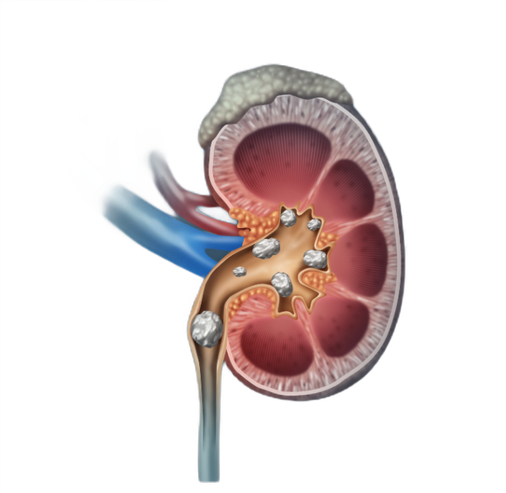The treatment procedure for kidney stones is majorly based on the size, number, and location of the stones. Kidney stones treatment involves two types of procedures – invasive and non-invasive surgery. There are overall four surgical procedures for the treatment of renal calculi or kidney stones –
- RIRS (Retrograde Intrarenal Surgery)
- Treated for stones size between 8mm to 15mm.
- The patient is under general anesthesia
- The urologist uses a thin, flexible ureteroscope to locate the stones.
- The stones are broken into smaller fragments with a tiny laser and expelled through urine.
- Stents are inserted through the urethra all the way to the ureter to enlarge the urinary tract for smooth movement of stones.
- Stents can either be removed on the same day or during the visit to the surgeon after the surgery.
- May require multiple sittings for the whole procedure
- ESWL (Extracorporeal Shock Wave Lithotripsy)
- It is a non-invasive surgery that uses shock waves to break kidney stones into smaller fragments.
- The procedure is done under spinal anesthesia
- The stone debris is expelled from the body through the urine.
- ESWL may require multiple sessions to break the stones completely.
- URSL (Ureteroscopic Lithotripsy)
- The patient is administered with general or spinal anesthesia.
- The surgeon inserts a thin tube called a ureteroscope which is passed through the urethra and into the ureter to remove the stone.
- The urologist uses a ureteroscope with a camera and light on the tip.
- The urologist locates the stone and breaks it into smaller fragments.
- The stone debris is flushed out of the body through the urine.
- PCNL(Percutaneous Nephrolithotomy/Nephrolithotripsy)
- The patient is under the effect of general anesthesia.
- PCNL is a minimally invasive surgery for the treatment of stone size more than 15mm.
- The urologist locates the stones with the help of a nephroscope.
- This surgery involves an incision of around 1cm in the flank area.
- Nephroscope locates the stones, and the urologist removes the stones consecutively.
- Stones can either be removed while they are intact or are broken into fragments and vacuumed out.
Risks and complications of untreated kidney stones.
Prolonging kidney stones can lead to several complications around the organs and tissue surrounding the stone. Sometimes, the size of the stone is large enough to obstruct the ureteral passage. It is a serious threat to the ureter, bladder, and other parts around the renal stone. Therefore, early diagnosis is very important to determine the presence of stones and prevent them before any major complications. Delaying kidney stones surgery can cause the following complications –
- Increased risk of urinary cancers
- Frequent infections in the urinary tract
- Inflammation of the kidneys due to restricted urine flow
- Injuries to the urinary tract
- Permanent damage in either kidney resulting in kidney failure
- Urinary bladder blockage that may result in painful urinary retention
Post-surgery care and restriction after undergoing kidney stones surgery
The patients are usually under the effect of spinal or general anesthesia. It may take time to regain consciousness completely. In the case of invasive surgery, there may be a slight discomfort around the site of the incision. Our urologists and surgeons at KidneyStonesDoctor guide the patients throughout the recovery and monitor their progress and ensure they are in the best of their health. Post-recovery tips after the kidney stones surgery include-
- Drink excess water every day
- Avoid spicy food for at least two months after the surgery
- Avoid food containing high animal proteins
- Do not stagnate yourself entirely from any physical activities
- Avoid too much physical activity that can put immense strain on your abdomen
- If there are stents inside you, you must not engage in too much exercise or outdoor sports.


